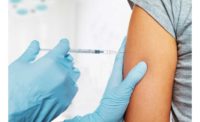
The people who worked at the warehouse where John Petropoulos died probably didn’t think their workplace was a killer. But guess what? Their workplace was a killer…and it left me without a husband.
On September 29th, 2000, Cst John Petropoulos of the Calgary Police Service responded to a break and enter complaint at a warehouse. He went into the building with the K-9 officer and his dog. John went up to the mezzanine level to search for the intruder, where he stepped from a safe surface directly onto a false ceiling. He fell nine feet into the lunchroom below and succumbed to a brain injury within hours.
John was 32. We both were.
The break and enter complaint turned out to be unfounded; there was no intruder in the building. Rather, it was a false alarm — the third that night — caused by the wind.
The subsequent investigation revealed that, according to legislation, there should have been a safety railing in place. Anyone could have fallen where John did. However, it was likely a familiar danger to those who worked at the warehouse on a regular basis, for there was a warning sign hanging from the roof…ten feet past the actual hazard.
So when John went into those unfamiliar surroundings in the dark to do his job of protecting the premise, he didn’t stand a chance.
“If our job as law enforcement officers is to protect the public and their interests,” said Darren Leggatt, the K-9 officer who went into the building with John, “the reality is that people need to take efforts to protect us while we’re protecting them.”
Emergency workers — police officers, firefighters and paramedics — have dangerous jobs, yes. However, when communities work together and people start to perceive the issue of workplace safety as a shared responsibility, there are many ways to minimize the risks these workers face on a daily basis.
Whether you work in a shopping mall, office building, warehouse, manufacturing plant, construction site, or on a ranch, farm, oil rig or refinery, there are ways you can help ensure emergency responders make it home safely to their families after every shift. And if you make your workplace safe for emergency workers, you make it safer for everyone.
Put yourself in their boots
Turn off the lights, trigger the alarm and put yourself in the boots of emergency responders who could be at your workplace during an emergency — such as a fire, crime in progress or medical crisis. Your workplace is their workplace…is it safe?No? Then make the change and save a life. Here’s how:
Tangible tips to make your workplace safe for everyone
- Remove all broken glass, sharp objects, tools, spills and debris.
- Keep hallways and exits clear of clutter. Firefighters work with limited amounts of air and need to move through and exit buildings quickly during a fire…every second counts. Paramedics navigate hallways with stretchers.
- Emergency exits should NEVER be locked, blocked or chained. If there is an EXIT sign about a door, people must be able to exit.
- Ensure safe storage of pallets and other stacked materials. Lighter items should be on top shelves; heavier items below.
- Ensure safe storage of hazardous and flammable materials.
- Keep alleyways and sidewalks clear and accessible for emergency vehicles and personnel.
- Install safety railings/guard and toe rails.
- Secure all scaffolding.
- Obtain a permit for all renovations. Have renovations done by a professional.
- Ensure proper placement of signage. Post close to the actual danger. Keep signage current for dangers and hazards that change.
- Ensure open holes are covered. Particularly important in industrial yards. Especially where there is no sensor lighting. Deal with culverts and sinkholes immediately.
- Ensure proper functioning of alarm systems. Test regularly. Deal with malfunctions and false alarms promptly.
- Ensure access points to construction sites are clearly marked for emergency services. At construction sites, stop overhead cranes and swinging loads when emergency responders are on scene — at both the emergency site and adjacent sites
- Conduct a regular hazard assessment by asking yourself: What could go wrong here? What can I do to make sure nothing goes wrong here?

How you can make the roads safer for emergency workers:
- Pay attention! Avoid distractions such as talking on the cell phone, texting, eating and applying make-up.
- Check rear view mirror regularly.
- Yield to emergency vehicles with lights activated. If an emergency vehicle comes up behind you, get out of the way in the safest possible manner.
- Slow down when passing emergency responders — and their vehicles — when they are stopped on the road…and give them room to work.
“We have to fear evil men but what we must fear more is the indifference of good men.”
-From the film, The Boondock Saints



